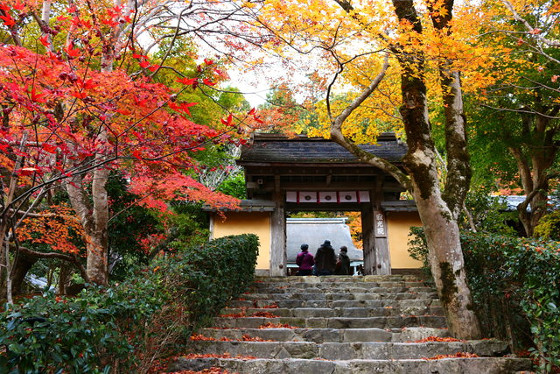The North-East Area of Kyoto includes the following famous temples:
The whole area (click the map to enlarge) can be visited by walk along the canal in about 50 mins.[1] This is a pleasant city stroll following the old canal, lined with cherry trees, between Ginkakuji Temple and Nanzenji Temple. Local scholars call the little alley flanking the canal "The Path of Philosophy".
Ginkakuji can be accessed by direct bus number
The whole area (click the map to enlarge) can be visited by walk along the canal in about 50 mins.[1] This is a pleasant city stroll following the old canal, lined with cherry trees, between Ginkakuji Temple and Nanzenji Temple. Local scholars call the little alley flanking the canal "The Path of Philosophy".
Temples
- Ginkakuji Temple (銀閣寺 Silver Pavilion)

- Is a Zen temple along Kyoto's eastern mountains (Higashiyama).
- Consists of the Silver Pavilion, half a dozen other temple buildings, a beautiful moss garden and a unique dry sand garden.
- Can be enjoyed by walking along a circular route around its grounds, from which the gardens and buildings can be viewed.
- Admission: 500 yen
- Hours:
- 8:30 to 17:00 (03/01 to 11/30)
- 9:00 to 16:30 (12/01 to 02/29)
- Eikando Temple (永観堂)

- Is very famous for its autumn colors and the evening illuminations that take place in fall[3]
- Eikando's most recognizable building is its Tahoto Pagoda, which is nestled in the trees on the hillside above the temple's other buildings.
- Visitors can walk up to the pagoda, from where the rest of the temple grounds and the city of Kyoto can be seen.
- The view from the pagoda is particularly attractive in autumn, when the maple trees of the temple grounds are changing colors.
- Another attractive spot during the fall is the Hojo Pond, around which an attractive garden has been cultivated.
- Autumn colors are usually best in the second half of November, when the temple is opened in the evening for special illuminations.
- Hours: 9:00 to 17:00 (entry until 16:00)
- Special evening hours during autumn illuminations.
- Admission: 600 yen (autumn daytime: 1000 yen, autumn nighttime: 600 yen)
- Nanzenji Temple (南禅寺)

- Whose spacious grounds are located at the base of Kyoto's forested Higashiyama mountains, is one of the most important Zen temples in all of Japan
- Nanzenji's central temple grounds are open to the public free of charge, but separate fees apply for entering temple buildings and subtemples.
- Hojo (former head priest's residence)
- Is most famous for its rock garden whose rocks are said to resemble tigers and cubs crossing through water.
- Also highly regarded are the paintings on fusuma (sliding doors), which include a more realistic depiction of tigers on gold leaf.
- Visitors enter the Hojo building complex through the former temple kitchen (kuri), where they can also find a small tea room to their right with a view of a miniture waterfall.
- Hours: 8:40 to 17:00 (until 16:30 from December to February)
- Admission ends 20 minutes before closing time.
- Admission: 500 yen
- Nanzenin Temple
- It includes a garden centered around a pond which becomes particularly attractive in autumn.
- Hours: 8:40 to 17:00 (until 16:30 from December to February)
- Admission ends 20 minutes before closing time.
- Admission: 300 yens
- Tenjuan Temple
- is noteworthy for its two gardens, a rock garden and a pond garden, which are particularly attractive during autumn when they are illuminated in the evenings.
- Admission: 400 yen (500 yen during the evening illumination)
- Hours: 9:00 to 17:00 (until 16:30 during winter)
Get There and Get Around
Ginkakuji can be accessed by direct bus number
- 5 (Bus Stop A-1)
- 17 (Bus Stop A-2)
- 100 (Bus Stop D-1)
Alternatively, you can reach Ginkakuji by foot along the Philosopher's Path from Nanzenji in about 30-45 minutes.
Photo Credit
- ema-mino.com
References
- Kyoto Walks (JNTO)
- Ginkakuji (Silver Pavilion)
- Japan: Best Autumn Color Spots near Kyoto (Travel for a Purpose)
- Jakuchu Revealed—300th Anniversary of Ito Jakuchu's Birth (Kyoto Municipal Museum of Art)
- October 4 (Tuesday) -December 4 (Sunday)
- 9 am - 5 pm
- Admission: based on the exhibition
- JAKUCHU The Divine Colors NHK Documentary (video)
- Kyoto Station (Kyoto Transportation Guide)
- Taking a bus in Kyoto
- Public Transport in Kyoto (important)
- Kyoto Guide: Kyoto Buses
- Kawaramachi Sanjo ⇒ Ginkakuji Mae (Ginkakuji Temple)
- Sanjo Keihan Mae ⇒ Ginkakuji Mae (Ginkakuji Temple)
- Arukumachi kyoto route planner (bus and train)
- Shirakawa-in Garden (白河院庭園)
- Kyoto 14 day weather forecast, Japan













